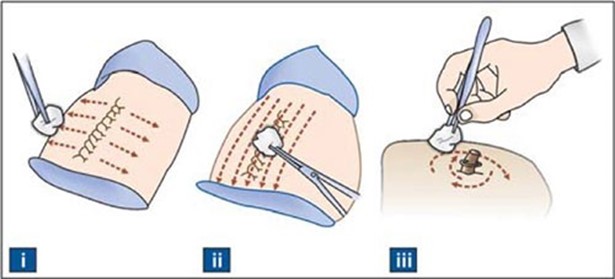Which technique is most appropriate for a nurse to use when cleansing a pressure ulcer?
Cleanse using hydrogen peroxide followed by betadine solution.
Cleanse the wound gently from the outer edges towards the center.
Cleanse using 4x4 gauze to the wound and surrounding skin three times.
Cleanse from the innermost point outwards with a circular movement.
The Correct Answer is D
Cleanse from the innermost point outwards with a circular movement. This technique reduces the risk of contaminating the wound with bacteria from the surrounding skin.

Some possible explanations for the other choices are:
Choice A is wrong because hydrogen peroxide and betadine solution can damage healthy tissue and delay wound healing.
Choice B is wrong because cleansing the wound from the outer edges towards the center can introduce bacteria from the skin into the wound.
Choice C is wrong because using 4x4 gauze to the wound and surrounding skin three times can cause trauma and bleeding to the wound.
Normal ranges for pressure ulcer stages are:
- Stage I: A reddened, painful area on the skin that does not turn white when pressed.
- Stage II: The skin blisters or forms an open sore. The area around the sore may be red and irritated.
- Stage III: The skin develops an open, sunken hole called a crater or ulcer. The tissue below the skin is damaged.
- Stage IV: The pressure ulcer has become so deep that there is damage to the muscle and bone, and sometimes to tendons and joints.
Nursing Test Bank
Naxlex Comprehensive Predictor Exams
Related Questions
Correct Answer is B
Explanation
This is because the pH of gastric contents is acidic (less than 5.5) and can indicate that the tube is in the stomach. This method is predictive of the correct placement of a nasogastric tube.
Choice A is wrong because fluoroscopy is not the most reliable method to confirm the correct placement of a nasogastric tube. It is an imaging technique that uses X-rays to show the movement of the tube, but it is not always available or feasible.
Choice C is wrong because injecting air and listening for gurgling sounds is not a reliable method to confirm the correct placement of a nasogastric tube. It can cause false-positive results and does not differentiate between the stomach and the respiratory tract.
Choice D is wrong because observing for bubbles after placing the end of the tube in a cup of water is not a reliable method to confirm the correct placement of a nasogastric tube. It can also cause false-positive results and does not differentiate between the stomach and the respiratory tract.
Correct Answer is C
Explanation
Determining whether chest pain has been relieved. This is because nitroglycerin is a medication that is used to treat chest pain caused by cardiac origin or acute pulmonary edema. The main action of nitroglycerin is to relax and dilate the blood vessels, which reduces the workload of the heart and improves blood flow to the heart muscle.
Therefore, the most important nursing action after administering nitroglycerin sublingually is to assess if the chest pain has subsided or not.
Choice A is wrong because monitoring the client’s respiratory rate and effort is not the most important action after giving nitroglycerin. Although nitroglycerin can cause hypotension and bradycardia, which may affect the respiratory status, these are side effects that can be managed and are not life-threatening as chest pain.
Choice B is wrong because warning the client to lie still to prevent a headache is not a priority after giving nitroglycerin. Nitroglycerin can cause headache as a side effect, but this can be treated with analgesics and does not require the client to lie still. Moreover, lying still may increase the risk of venous thromboembolism in a client with peripheral vascular disease.
Choice D is wrong because verifying that the sublingual tablet produced a tingling sensation is not essential after giving nitroglycerin.
Although some sublingual tablets may produce a tingling sensation, this is not a reliable indicator of the drug’s effectiveness
Whether you are a student looking to ace your exams or a practicing nurse seeking to enhance your expertise , our nursing education contents will empower you with the confidence and competence to make a difference in the lives of patients and become a respected leader in the healthcare field.
Visit Naxlex, invest in your future and unlock endless possibilities with our unparalleled nursing education contents today
Report Wrong Answer on the Current Question
Do you disagree with the answer? If yes, what is your expected answer? Explain.
Kindly be descriptive with the issue you are facing.
